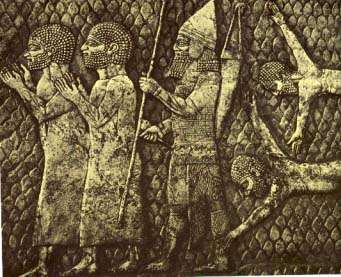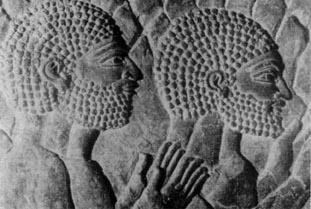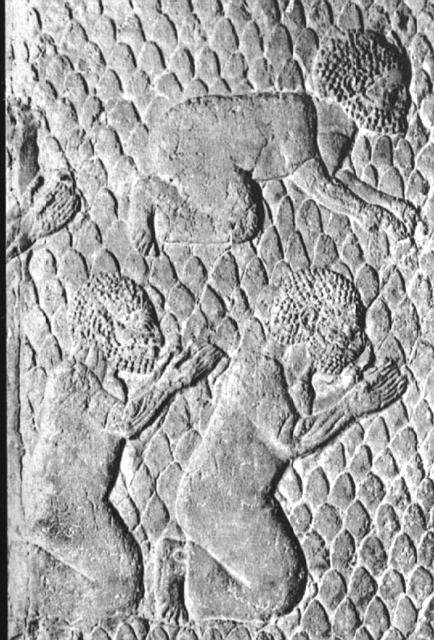

Assyrian Record of Ancient Jewish Phenotypes

Uncovered by the archaeologist Austen Layard in 1846, the reliefs in
Sennacherib's southwest palace at Kouyunjik still breed controversy.
Layard's description of this find:
"Here, therefore, was the actual picture of the taking of Lachish,
the city, as we know from the Bible [2 Kings 18:14; Isaiah 36:2], besieged
by Sennacherib, when he sent his generals to demand tribute of Hezekiah,
and which he captured before their return .... The captives were undoubtedly
Jews - their physiognomy was strikingly indicated in the sculptures; but
they had been stripped of their ornaments and their fine rainment, and were
left barefoot and half-clothed."
In 1854 the anthroplogists Nott and Gliddon declared the reliefs not
to be the "true Hebrew physiognomy" because not bearing preconceived
notions of straight hair, flowing beard, and "Hittite nose."
Today's anthropologists, rather than bluntly admit their displeasure of
the reality versus fanciful notions and stilted stereotypes, issue
positions such as that of the American School of Oriental Research. They
say that all the Assyrian reliefs are generic in nature and not
factual representations. However, Ruth Jacoby -- the anthropologist who
first put forth this opinion -- maintains that the facial features of
the people are accurate and authentic representations (Israel Exploration
Journal 1991 41:112-31).
Isn't it amazing how when a certain phenotype is present all kinds of
ingenious arguments are proposed to wish away its presence? Why is it
that no other type of humanity when depicted or its osteo-remains found
in situ generate disbelief in its veracity as do these?
What serves to confirm the ethnic reality depicted by Assyrian
conquerers is the discovery of an ossuary at Lachish dated to
the time of the conquest. It is the largest sample of Israelites
and comes from a city that was populated previously for 500
years by Israelites. 695 crania of all ages and gender were
uncovered.
D. L. Risdon in BIOMETRIKA 1939 31:99-166, reports that the Lachish
cranial series has its closest resemblance to the 4th dynasty series from
Deshasheh and Medum in Lower Egypt and the 18th dynasty samples from
Thebes and Abydos in Upper Egypt. Cranial samples from other Palestinian
sites (Gezer, Megiddo) agree with the Lachish cranium. Thus we have a
clear Afrikan phenotypical continuum in the southern Hebrews of Judah
based on their physical similarity to Egyptians.

From slabs 5 and 8 of room 36
|
|
| Judahite captive deportees of Lachish |
 |
| Facial profiles of Jews circa 680 BCE |
 |
| Top three of the surviving government body of Lachish |
 |

SR' Yafeu ibn Taom
© 1997, 2002, 2003 RCAJA® All rights reserved world wide.

Jewish race Jews race Jew's race race of the Jews
Jewish ethnicity physical type antiquity Judah
African Jews of Africa negro jews black jews colored jews